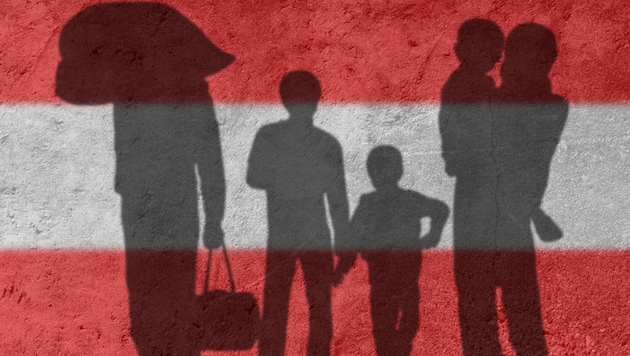Figures for the first time
Asylum decisions trigger small “mass migration”
For the first time, the "Krone" now has analyses on the relocation behavior of persons entitled to asylum and subsidiary protection within Austria. They paint a picture that many suspected, but no one could prove. Only now is it clear how refugees are distributed in Austria after recognition. And why, in the end, one province is particularly in focus.
After a positive asylum or protection decision, many things change for those affected - their place of residence, prospects, support services. Until now, it was only possible to guess how much this phase actually changes the demographic picture of Austria. These new data sets, which the Austrian Integration Fund (ÖIF) prepared for the first time at the request of the "Krone", now close a gap: They show how many people change their place of residence after recognition and where they go.
Migration within Austria
A remarkable pattern emerges for the year 2024. Of the 3,930 people who received a positive decision for the first time in the previous year and did not live in Vienna, almost half changed their place of residence - 46%, and mostly very quickly. 82% of these people moved within the first three months. This shows that the phase following recognition is not just an administrative phase, but a phase of massive mobility within Austria.
Noticeable shifts between the federal provinces
The movement is particularly strong among beneficiaries of subsidiary protection. While 60.1% moved to Vienna after recognition in 2023, the proportion was lower in 2024, but at 56.2% it was still significantly higher than previously assumed. The regional differences are huge.
In some federal states, more than half of those entitled to subsidiary protection leave the region shortly after recognition. In Upper Austria it is 69 percent, in Carinthia 68 percent, in Burgenland 67 percent, in Styria and in Lower Austria 65 percent each. Interesting: Those federal states that top up the minimum benefits for beneficiaries of subsidiary protection are rarely left. Just under one in ten (9 percent) leave Tyrol, while only two percent leave Vienna.
Many only know one destination
The question of destination is even more spectacular. The ÖIF data shows that these movements are not scattered, but in the vast majority of cases lead in the same direction - namely Vienna. For Upper Austria and Styria, the proportion of those who move after recognition and then end up in Vienna is 94% in each case. The figure for Lower Austria is 92 percent and 90 percent for Burgenland. This is the first time that this has been clearly documented: The overwhelming majority of migration within Austria after recognition leads to Vienna.
Social spending unevenly distributed
This long-term development is also reflected in the current figures for social welfare and minimum benefits. While the responsible Vienna Municipal Department (MA40) has still not published the 2024 annual report, at least Statistics Austria is following suit. In the previous year, an average of 206,000 people in Austria received minimum benefits or social assistance. The majority of these - 149,000 people - lived in Vienna. This means that around three-quarters of those dependent on support have settled in Vienna.
And what about immigrants? The 149,000 recipients include 60,000 people entitled to asylum and 12,600 people entitled to subsidiary protection. Even more clearly: 60,135 of the 77,648 people entitled to asylum and receiving minimum benefits or social assistance in Austria live in Vienna. Of the 13,652 persons entitled to subsidiary protection in the minimum benefits or social assistance system, 12,647 live in Vienna - in other words, the overwhelming majority.
First-hand explanations - and they sound clear
Why this is the case has been discussed for a long time. But the answers from those affected themselves are surprisingly open. A recently published AMS study contains interviews with Syrian refugees who clearly explain their choice of place of residence. One man puts it like this: "Services and financial support are better in Vienna than in other federal states. But I find other federal states nicer than Vienna." Another interviewee simply explained that he had moved to Vienna because of his subsidiary status, "because the financial support is better there". The combination of the density of courses, infrastructural offers and a larger community is another factor. However, only the new ÖIF figures make it clear how strongly these motives are reflected in actual behavior.
Special features are also evident in the labor market
The AMS data adds another aspect to the picture: integration in the labor market is slower in Vienna than in other federal states. Syrian refugees find employment more quickly in Upper Austria or Styria, whereas in Vienna they are more likely to remain unemployed or on courses for longer. Several factors play a role: lower German language skills in the Viennese sample, less formal education, fewer previous professional commitments. This results in a paradox: Vienna attracts the most people after recognition - but is at the same time the federal state in which entry into the labor market is particularly slow.
Vienna draws the consequences
The city has now responded to this development with a welfare reform that will take effect from 2026. From the beginning of the year, beneficiaries of subsidiary protection will lose their entitlement to minimum benefits and will revert completely to basic welfare support - even those already living in Vienna. The city is thus deliberately breaking with its previous special approach. Vienna is also reducing the housing shares for families, which, according to the city hall, means that a family of five will receive around 400 euros less per month. In future, shared flats will be treated as communities of need, which will reduce the benefits per person. At the same time, the child rates will remain the same: 326 euros per child, regardless of the number.
This article has been automatically translated,
read the original article here.



Kommentare
Willkommen in unserer Community! Eingehende Beiträge werden geprüft und anschließend veröffentlicht. Bitte achten Sie auf Einhaltung unserer Netiquette und AGB. Für ausführliche Diskussionen steht Ihnen ebenso das krone.at-Forum zur Verfügung. Hier können Sie das Community-Team via unserer Melde- und Abhilfestelle kontaktieren.
User-Beiträge geben nicht notwendigerweise die Meinung des Betreibers/der Redaktion bzw. von Krone Multimedia (KMM) wieder. In diesem Sinne distanziert sich die Redaktion/der Betreiber von den Inhalten in diesem Diskussionsforum. KMM behält sich insbesondere vor, gegen geltendes Recht verstoßende, den guten Sitten oder der Netiquette widersprechende bzw. dem Ansehen von KMM zuwiderlaufende Beiträge zu löschen, diesbezüglichen Schadenersatz gegenüber dem betreffenden User geltend zu machen, die Nutzer-Daten zu Zwecken der Rechtsverfolgung zu verwenden und strafrechtlich relevante Beiträge zur Anzeige zu bringen (siehe auch AGB). Hier können Sie das Community-Team via unserer Melde- und Abhilfestelle kontaktieren.










